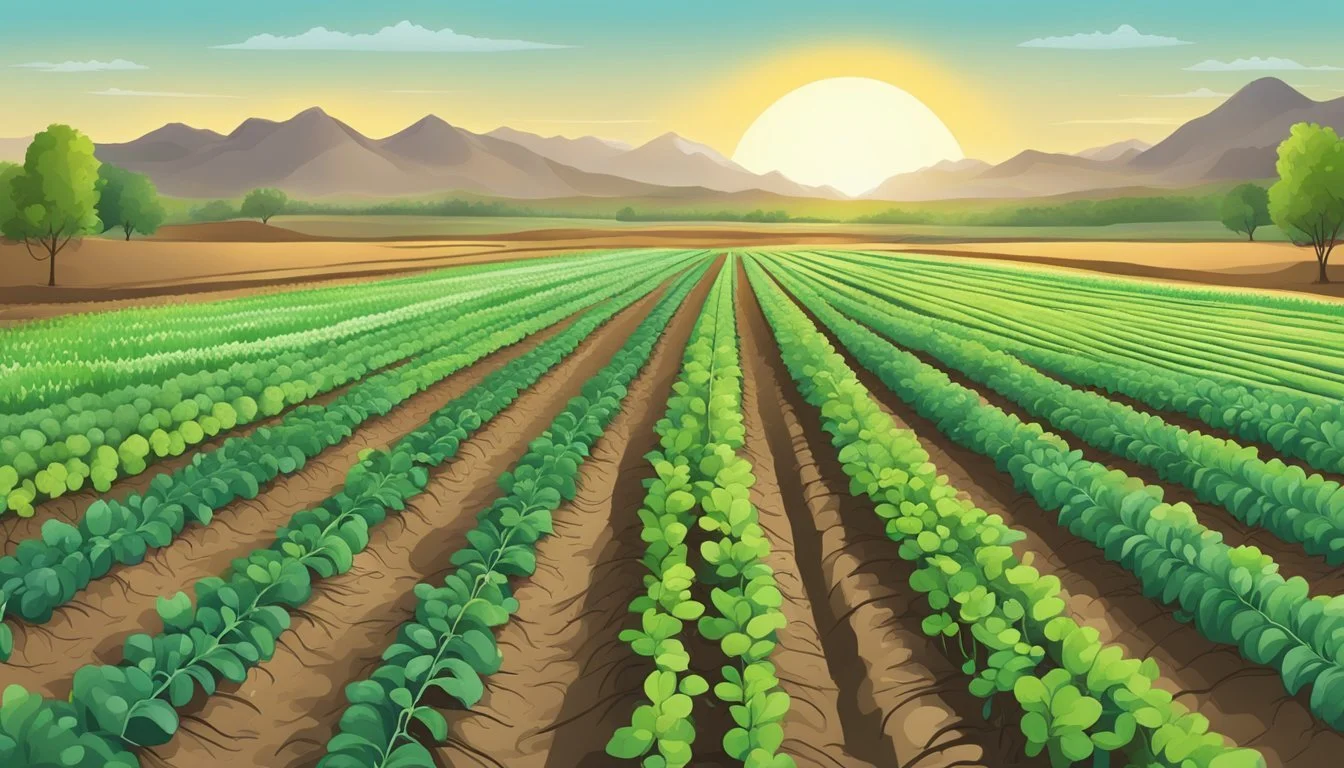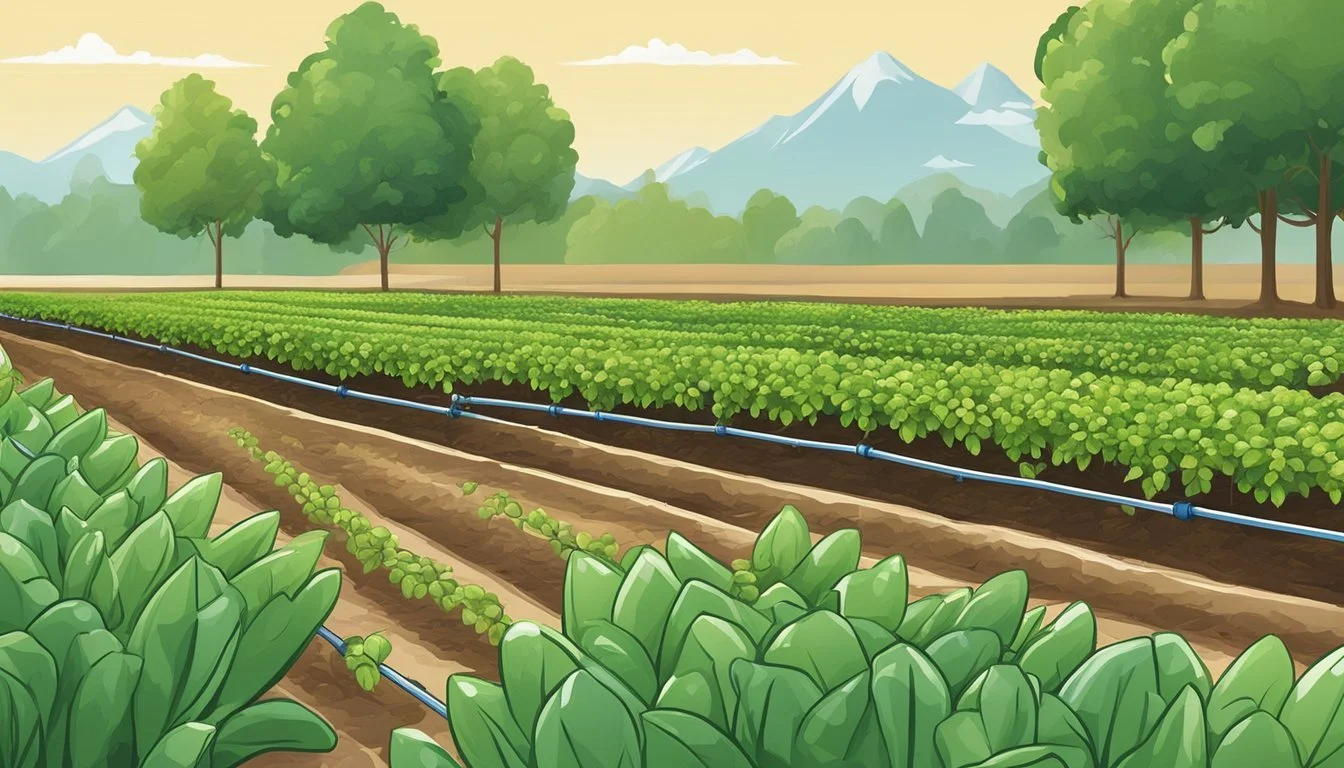Advantages of Drip Irrigation
Maximizing Water Efficiency in Agriculture
A drip system is a highly efficient method of watering plants that delivers water directly to the soil at a slow, steady rate, allowing the moisture to seep directly into the roots. Also known as micro-irrigation or trickle irrigation, the system maximizes water usage by minimizing evaporation and runoff. The targeted delivery system ensures that water is not wasted on non-growth areas and helps maintain optimal soil moisture levels to promote plant productivity and quality.
The technique stands out for its ability to provide consistent moisture directly to plant roots while keeping the foliage dry, thus reducing the potential for disease. Unlike traditional watering methods, such as sprinklers, which can promote the growth of weeds by watering the entire plot, drip irrigation keeps row spaces dry, discouraging weed growth. This cultivates healthier plants and simplifies maintenance for gardeners and farmers by reducing the need for weeding. Even small systems aimed at home gardeners save time and water once set up, whether installed for container plants or flower beds.
Each drip system is versatile and can be tailored to suit different landscapes, such as uneven terrain and irregular field shapes. This adaptability, combined with the ability to conserve water and increase crop yields, makes it a sustainable choice for many applications in different climates, especially in regions facing water scarcity and drought conditions. By delivering water at a rate that matches the absorption ability of the soil, drip irrigation ensures that water penetrates deeply rather than running off, which is beneficial for deep-rooted plants and helps in nutrient uptake.
Water Conservation and Efficiency
Drip irrigation stands out in the realm of agriculture for its superior water conservation and efficiency. By directly targeting the root zone, this irrigation method minimizes waste and maximizes water usage.
Reduced Evaporation and Runoff
Traditional sprinkler systems disperse water over a wide area, much of which is lost to evaporation and runoff. In contrast, a drip system delivers water directly to the soil surface, significantly reducing losses from evaporation. Runoff is also minimized as water is applied slowly and absorbed by the plants' root zones, making it an ideal solution for row crops and for water conservation.
Precision Watering to the Root Zone
The root zone is where plants absorb most of their water and nutrients. Drip irrigation ensures precision watering by releasing water drop by drop directly to this vital area. This targeted approach prevents water wastage around non-essential areas and optimizes plant health by supplying water where it's most needed.
Enhanced Water Use Efficiency
Drip irrigation transforms water usage into a highly efficient process. Using adjustable emitters for each soil type, it supplies water at a rate that the earth can absorb, so plants grow avoiding the excess that characterizes sprinkler systems. This reduces overall water use and allows for precise control over irrigation timing, further enhancing water efficiency and supporting sustainable agriculture practices.
System Design and Installation Advantages
Drip irrigation offers notable benefits in the design and installation phase, providing flexibility and efficiency on various landscapes.
Suitability for Varied Terrains
On flat terrain and uneven landscapes alike, a drip irrigation system demonstrates a high degree of adaptability. They are particularly effective in areas such as hillsides and vineyards, where traditional watering methods may be inefficient or impractical. The precise placement of drip emitters ensures that water is delivered directly to the plant roots, regardless of the terrain's inclination.
Flat Terrain: Ensures uniform distribution of water across the field.
Hillsides: Reduces runoff and erosion by applying water directly to the root zone.
Ease of Installation and Expansion
The installation process of a drip irrigation system is streamlined due to their modular design. Starting small and expanding the system as needed is a practical option for many growers. Whether it's for a small garden or an expansive vineyard, installers can easily add or rearrange tubing and emitters without overhauling the entire infrastructure.
Modular Components: Allows for phased installation which can be scaled up over time.
Simplicity: Straightforward installation process that doesn't require specialized tools or extensive labor.
Customizable Layout and Components
A key advantage of drip irrigation is its customizability. Installers can tailor the layout to the specific needs of the plants and the topography of the landscape. With various components such as emitters, hoses, and connectors, systems can be designed to address individual plant requirements, further optimizing water usage and promoting healthier growth.
Layout Flexibility: Design the system for uniform water distribution regardless of plant spacing.
Component Variety: Choose from an array of emitters and micro-sprinklers to meet unique watering needs.
Agricultural and Gardening Benefits
Drip irrigation stands as a pivotal tool for gardeners and agricultural producers, improving both crop yields and plant health while offering better control over weeds and diseases.
Increased Crop Yields
Crop yields benefit significantly from a drip irrigation system because they deliver water straight to the plant's root zone, where it is most needed. Whether tending a vegetable garden or a larger commercial application there will be an increase in productivity as crops receive a precise amount of water, avoiding the stress of too much or too little hydration.
Consistency: Drip irrigation provides a steady and controlled water supply, promoting steady plant growth without periods of water stress.
Efficiency: By minimizing water loss due to evaporation and runoff, more water reaches the plants, which can lead to increased yields over time.
Optimal Plant Health and Growth
Roots receive water and nutrients on a targeted basis, which encourages strong and healthy growth in both vegetable garden plants and crops. Here's how:
Nutrient Delivery: Alongside water, nutrients can be fed through the system, ensuring that plants get a balanced feeding schedule, and enhancing their overall health.
Leaf Dryness: Leaves remain dry, reducing the instances of discoloration and spotting caused by excess moisture, and thereby also avoiding disease-promoting conditions.
Control of Weed and Disease Incidence
A strategic advantage of drip irrigation is its indirect role in weed and disease control.
Reduces Weeds: By directly watering plants, drip irrigation limits the water supply to potential weed growth surrounding the crops. This targeted watering approach creates a less favorable environment for weeds.
Disease Mitigation: Dryer surface conditions discourage the proliferation of many plant diseases, which often require moist conditions to thrive. This controlled watering technique reduces the incidence of leaf and root diseases.
Resource Management and Environmental Impact
Drip irrigation stands as a paradigm of efficient resource management with pronounced positive impacts on the environment. It enhances water source management, minimizes earth erosion and nutrient runoff, and reinforces sustainable agricultural practices.
Water Source Management
One of the foremost advantages of a drip system is the savvy management of water sources. Whether the delivery is by drip tube or drip tape it precisely delivers water directly to the plant roots, thereby reducing water usage by an estimated 20% to 60% compared to traditional methods. Whether for a vegetable garden or a larger commercial plot growers can maintain optimal hydration of plants while conserving a vital resource.
Minimization of Soil Erosion and Nutrient Runoff
Drip irrigation contributes significantly to the preservation of soil integrity. By avoiding the over-saturation of the earth, it prevents soil erosion—a process that can lead to loss of fertile land. Moreover, it curtails nutrient runoff, ensuring that soils retain their nutrients necessary for the healthy growth of plants. This targeted watering method mitigates one of the major environmental concerns associated with agriculture.
Contribution to Sustainable Practices
Deploying drip irrigation is a clear step towards sustainable agriculture. It conserves not only water but also reduces the need for fertilizers and energy, thereby lowering the carbon footprint of farming activities. Farmers can achieve higher productivity on a given plot of land, all the while fostering an eco-friendly approach to food production.
Cost and Labor Efficiency
A drip irrigation system offers a twofold advantage: they reduce the use of both water and energy, leading to significant savings in cost and labor.
Reduced Labor and Energy Requirements
Drip irrigation stands out for its energy-efficient operation, as it supplies water directly to the root zone of plants, reducing the amount of energy required to pump water compared to traditional irrigation methods. By operating at a lower pressure than many other irrigation systems, it conserves energy. Demand for manual labor is lessened as the systems can be easily automated, allowing farm personnel to be allocated to other tasks, and enhancing overall productivity.
Decreased Need for Fertilizers and Pesticides
The precise application of water also contributes to the reduction in fertilizer and pesticide use. By limiting water to the immediate vicinity of the plant roots, drip irrigation minimizes runoff and evaporation, and consequently, less fertilizer is washed away. This not only lessens the environmental impact but also results in financial savings due to less frequent and more efficient use of these inputs.
System Reliability and Control
The reliability and control of a drip irrigation system are paramount to its efficiency. Through the integration of automated timers, calibrated water distribution, and the use of advanced sensors and regulators, these systems offer unparalleled precision in water delivery.
Automated Watering with Timers
Automated timers are a key component in any drip irrigation system, allowing for consistent and timely watering schedules without the need for manual intervention. These devices can be programed to initiate irrigation at specific times, ensuring plants receive water exactly when needed.
Timers: Ensure consistent water schedules.
Automated: Reduce manual labor and oversight.
Uniform Water Distribution
Each drip irrigation system is designed to deliver water evenly across the planting area, which is essential for the health and consistent growth of crops. Uniform water distribution is achieved through carefully designed drip emitters that release water at a controlled rate.
Uniformity: Prevents over- or under-watering.
Efficient Irrigation System: Promotes equal opportunity for all plants to thrive.
Advanced Control with Sensors and Regulators
Incorporating sensors and a pressure regulator adds a layer of precision to drip irrigation systems. These drip irrigation parts have different roles. Sensors can monitor earth moisture levels and automate watering based on real-time needs, while pressure regulators maintain the optimal water pressure to ensure uniform distribution and prevent system damage.
Sensors: Adapt watering to real-time environmental conditions.
Pressure Regulators: Maintain system integrity and performance.
Disadvantages of Drip Irrigation
While drip systems are renowned for its efficiency in water distribution to plants, it does come with certain disadvantages. These issues may affect the long-term functionality and cost-effectiveness of the system.
Potential for Clogging
Any drip irrigation kit can be susceptible to clogging. The minute water pathways can easily become blocked by mineral deposits, dirt, or organic matter. Regular maintenance is required to monitor and clean filters and emitters to prevent clogging, which can lead to uneven water distribution to the plants.
Risk of Overwatering and Underwatering
Despite precise water delivery, drip irrigation systems carry the risk of overwatering or underwatering if not properly managed. Overwatering can occur if the system is left running too long, while underwatering may happen if emitters are not placed close enough to the plant roots or if the water output is insufficient.
Maintenance and Repair Considerations
The maintenance and repair of drip irrigation demand vigilance and labor. Systems can be damaged by garden tools, UV exposure, and wear and tear. Regular inspections are necessary to address leaks, breaks, and worn-out parts to ensure the system's efficiency, which can incur additional costs and effort.





